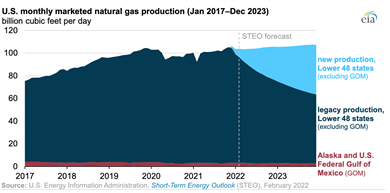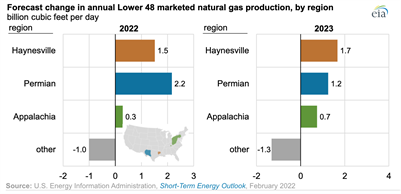U.S. marketed natgas production forecast to rise in 2022 & 2023
(EIA) — The EIA forecasts that U.S. natural gas marketed production will increase to an average of 104.4 Bft3d in 2022 and then further increase to a record-high 106.6 Bft3d in 2023. Around 97% of production over the next two years will come from the lower 48 states (L48), excluding the Federal Offshore Gulf of Mexico (GOM). The other 3% will come from Alaska and the GOM.

The EIA estimates that the wholesale spot price of natural gas at the U.S. benchmark Henry Hub will average $3.92 per million British thermal units (MMBtu) in 2022, an 8-year high, and will average $3.60/MMBtu throughout 2023. They expect these elevated prices will drive continued increases in U.S. drilling activity and natural gas production.
The EIA forecasts that legacy production—production from wells drilled before December 2021—in the L48 will average 83.2 Bft3d in 2022 and fall 21% to 65.9 Bft3d in 2023. However, production from new wells will contribute 18.1 Bft3d in 2022 and increase to 37.8 Bft3d in 2023, offsetting declining production from legacy wells and bringing total L48 marketed gas production to 103.7 Bft3d in 2023.
U.S. natural gas production growth will primarily come from the Appalachia region in the Northeast, the Permian region in western Texas and southeastern New Mexico, and the Haynesville region in Texas and Louisiana.
Haynesville production will grow by 1.6 Bft3d annually, on average, in the next two years, according to the EIA's STEO forecast. As natural gas prices remain elevated, drilling in the Haynesville region remains economical, even with relatively deeper and more expensive well development. In addition, Haynesville’s greater well productivity and its proximity to LNG export terminals and major industrial natural gas consumers along the U.S. Gulf Coast draws operators to the region.
The EIA forecasts that the Permian region will contribute 2.2 Bft3d to production growth in 2022 and 1.2 Bft3d in 2023. Our forecast for the West Texas Intermediate crude oil price remains above $60 per bbl, prompting operators to increase oil-directed drilling activity in the region, which would also increase associated gas production.
In recent years, the Appalachia region has provided the largest share of U.S domestic natural gas output, accounting for one-third of L48 production annually since 2016. Although production growth has slowed in recent years because of less drilling activity and emerging pipeline capacity constraints, Appalachia well-level productivity has been increasing, offsetting some of the drilling decline. The EIA estimates that production from the Appalachia region will grow by 0.3 Bft3d in 2022 and 0.7 Bft3d in 2023.

Principal contributor: Naser Ameen

- ADNOC Gas awards $2.1 B in contracts to enhance LNG supply infrastructure
- U.S. Department of the Treasury releases final rules for clean hydrogen production tax credit
- Tecnimont to build waste-to-biogas plant to fuel local kitchens in India
- Indonesia regulator confirms disruption at bp's Tangguh LNG project
- Topsoe, Aramco sign JDA to advance low-carbon hydrogen solutions using eREACT™



Comments